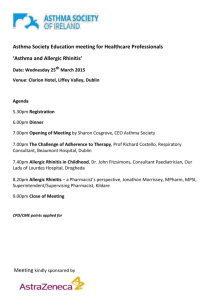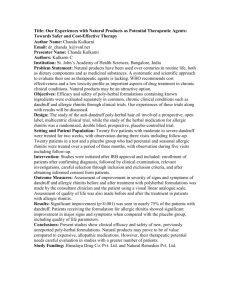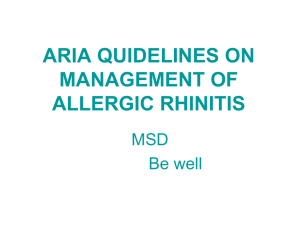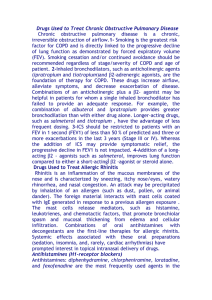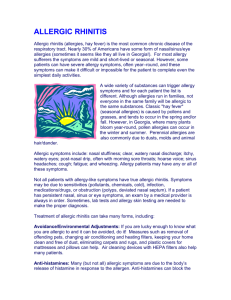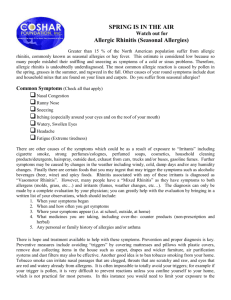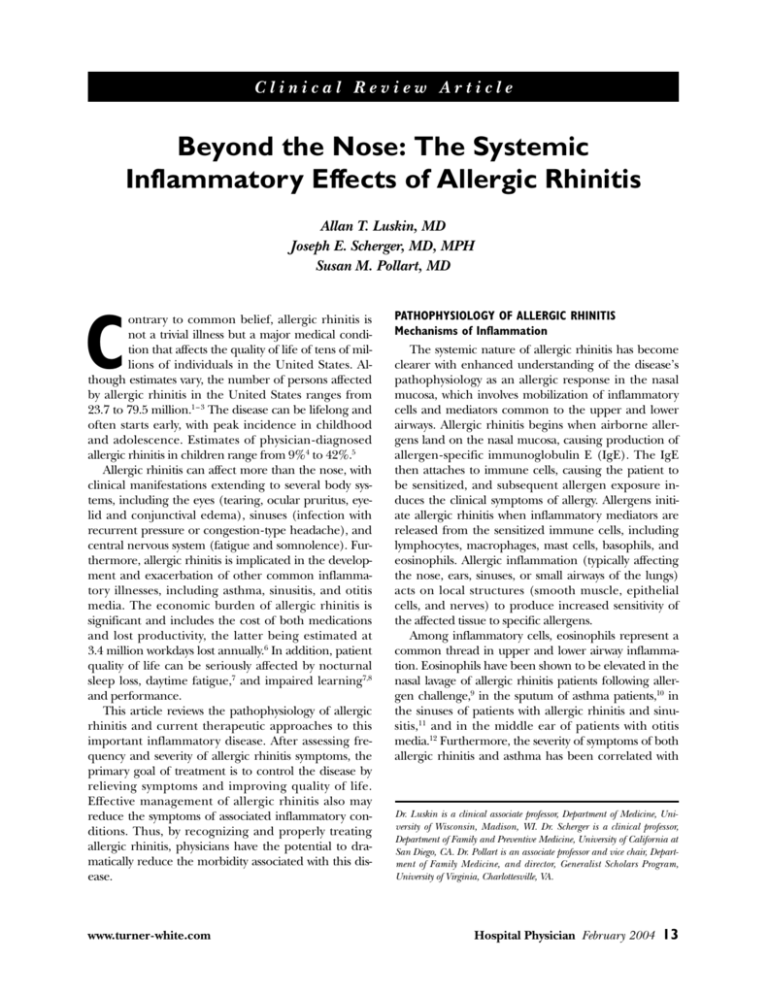
Clinical Review Article
Beyond the Nose: The Systemic
Inflammatory Effects of Allergic Rhinitis
Allan T. Luskin, MD
Joseph E. Scherger, MD, MPH
Susan M. Pollart, MD
ontrary to common belief, allergic rhinitis is
not a trivial illness but a major medical condition that affects the quality of life of tens of millions of individuals in the United States. Although estimates vary, the number of persons affected
by allergic rhinitis in the United States ranges from
23.7 to 79.5 million.1 – 3 The disease can be lifelong and
often starts early, with peak incidence in childhood
and adolescence. Estimates of physician-diagnosed
allergic rhinitis in children range from 9%4 to 42%.5
Allergic rhinitis can affect more than the nose, with
clinical manifestations extending to several body systems, including the eyes (tearing, ocular pruritus, eyelid and conjunctival edema), sinuses (infection with
recurrent pressure or congestion-type headache), and
central nervous system (fatigue and somnolence). Furthermore, allergic rhinitis is implicated in the development and exacerbation of other common inflammatory illnesses, including asthma, sinusitis, and otitis
media. The economic burden of allergic rhinitis is
significant and includes the cost of both medications
and lost productivity, the latter being estimated at
3.4 million workdays lost annually.6 In addition, patient
quality of life can be seriously affected by nocturnal
sleep loss, daytime fatigue,7 and impaired learning7,8
and performance.
This article reviews the pathophysiology of allergic
rhinitis and current therapeutic approaches to this
important inflammatory disease. After assessing frequency and severity of allergic rhinitis symptoms, the
primary goal of treatment is to control the disease by
relieving symptoms and improving quality of life.
Effective management of allergic rhinitis also may
reduce the symptoms of associated inflammatory conditions. Thus, by recognizing and properly treating
allergic rhinitis, physicians have the potential to dramatically reduce the morbidity associated with this disease.
C
www.turner-white.com
PATHOPHYSIOLOGY OF ALLERGIC RHINITIS
Mechanisms of Inflammation
The systemic nature of allergic rhinitis has become
clearer with enhanced understanding of the disease’s
pathophysiology as an allergic response in the nasal
mucosa, which involves mobilization of inflammatory
cells and mediators common to the upper and lower
airways. Allergic rhinitis begins when airborne allergens land on the nasal mucosa, causing production of
allergen-specific immunoglobulin E (IgE). The IgE
then attaches to immune cells, causing the patient to
be sensitized, and subsequent allergen exposure induces the clinical symptoms of allergy. Allergens initiate allergic rhinitis when inflammatory mediators are
released from the sensitized immune cells, including
lymphocytes, macrophages, mast cells, basophils, and
eosinophils. Allergic inflammation (typically affecting
the nose, ears, sinuses, or small airways of the lungs)
acts on local structures (smooth muscle, epithelial
cells, and nerves) to produce increased sensitivity of
the affected tissue to specific allergens.
Among inflammatory cells, eosinophils represent a
common thread in upper and lower airway inflammation. Eosinophils have been shown to be elevated in the
nasal lavage of allergic rhinitis patients following allergen challenge,9 in the sputum of asthma patients,10 in
the sinuses of patients with allergic rhinitis and sinusitis,11 and in the middle ear of patients with otitis
media.12 Furthermore, the severity of symptoms of both
allergic rhinitis and asthma has been correlated with
Dr. Luskin is a clinical associate professor, Department of Medicine, University of Wisconsin, Madison, WI. Dr. Scherger is a clinical professor,
Department of Family and Preventive Medicine, University of California at
San Diego, CA. Dr. Pollart is an associate professor and vice chair, Department of Family Medicine, and director, Generalist Scholars Program,
University of Virginia, Charlottesville, VA.
Hospital Physician February 2004
13
Luskin et al : Allergic Rhinitis : pp. 13 – 22
the degree of eosinophilia in the nose9 and sputum,10
respectively. For many patients with perennial and seasonal allergy, ongoing inflammation of the nose is a
problem even if the patients are apparently symptom
free. This minimal persistent inflammation is present during periods of minimal allergen exposure.13–15
The inflammatory mediators released after allergen challenge are common to both the upper and
lower airways. These mediators include histamine, cysteinyl leukotrienes (ie, LTC4, LTD4, and LTE4), prostaglandins, kinins, and neuropeptides.16 In the socalled early-phase reaction that occurs minutes after
allergen challenge, histamine is released into nasal
secretions and produces vasodilation, increased capillary leakage, and mucus secretion.17,18 Histamine
binds to H1 receptors, leading to the well-known symptoms of sneezing,19,20 pruritus,20,21 rhinorrhea,20,22 and
(to some extent) congestion.20,21
In the so-called late-phase reaction that occurs 4 to
5 hours after allergen challenge, newly synthesized cysteinyl leukotrienes and prostaglandins attract more
inflammatory cells (eosinophils, basophils, and activated
T cells) to the area. These cells, in turn, generate more
inflammatory mediators, exacerbating local inflammation.16,23 Levels of cysteinyl leukotrienes increase in the
nasal fluid of allergic patients.24 The cysteinyl leukotrienes are 5000 times more potent than histamine in
inducing nasal response.22 In nasal and bronchial tissues, leukotrienes cause vascular permeability, tissue
edema, airway mucus secretion, impaired ciliary clearance, and accumulation of inflammatory cells.22,25 In
the lower airway, they produce bronchoconstriction.23
Additionally, the cysteinyl leukotrienes may help
eosinophils survive by decreasing their apoptosis, thereby maintaining eosinophilic inflammation.26 These
inflammatory cells produce a variety of chemokines
and cytokines that produce and augment tissue inflammation and hyperreactivity.
Common Associated Inflammatory Diseases
Allergic rhinitis often is associated with other inflammatory diseases.27,28 These diseases share common
inflammatory mediators with allergic rhinitis, which
may explain why treating allergic rhinitis may improve
comorbid conditions.
Asthma is diagnosed in 21%29 to 58%30 of patients
with allergic rhinitis; conversely, 86%29 to 92%31 of
patients with asthma are diagnosed with allergic rhinitis. In children, allergic rhinitis can be a risk factor for
developing asthma5; 22% of those with diagnosed allergic rhinitis also are found to have asthma.4 Underlying
14 Hospital Physician February 2004
asthma may be exacerbated by altered bronchial responsiveness resulting from allergic rhinitis.32 Mouth
breathing, which often is caused by nasal obstruction
in allergic rhinitis, also can elicit asthma-like symptoms
and potentiate lower airway hyperresponsiveness and
exercise-induced bronchospasm.33
Up to 53% of patients with allergic rhinitis have
coexistent sinusitis.34 Conversely, 25%35 to 58%36 of
patients with sinusitis have allergic rhinitis. In allergic
patients, sinusitis can worsen after nasal allergen challenge, as evidenced by radiographic changes in the
maxillary sinuses.37
Allergic rhinitis also can be associated with otitis
media, especially in children younger than 15 years, in
whom otitis media with effusion (OME) represents up
to 11.8% of total visits to a physician for any reason
(2.7% for the general population).38 Of children with
allergic rhinitis, 21% were found to have OME,39,40
whereas 50%39 of children diagnosed with chronic OME
had concomitant allergic rhinitis. Allergic rhinitis also
can be associated with acute or perennial allergic conjunctivitis, leading to tearing, itching, and burning of
the eyes.
APPROACH TO MANAGEMENT OF ALLERGIC RHINITIS
Therapeutic Goals
Appropriate management of allergic rhinitis not
only improves symptoms of the disease but also concomitantly reduces inflammation and improves comorbid inflammatory conditions. Conversely, poorly
controlled allergic rhinitis can contribute to the development or worsening of other diseases and conditions,
including acute and chronic sinusitis, recurrence of
nasal polyps, otitis media, hearing impairment, abnormal craniofacial development, and sleep apnea.41
The primary goal of allergic rhinitis management
should be control of the disease by relief of symptoms
and improvement of quality of life. Successful treatment should result in no complications of allergic
rhinitis, including uncontrolled asthma; otitis media;
sinusitis; frequent upper respiratory infections; or abnormalities in learning, memory, alertness, performance, multitasking, mood, or behavior. Environmental and social factors should be optimized to allow
patients to lead a normal life.
Matching Therapy to Disease Severity
In 2001, a World Health Organization initiative culminated in the publication of the Allergic Rhinitis and
its Impact on Asthma (ARIA) guidelines, which propose
a disease classification model on which to base allergic
www.turner-white.com
Luskin et al : Allergic Rhinitis : pp. 13 – 22
Intermittent
• Symptoms ≤ 4 days/week
OR
• Symptoms ≤ 4 weeks/year
Moderate-severe
Mild
Mild
All of the following:
• Normal sleep
• No impairment of daily
activities, sport, leisure
• Normal work/school
• No troublesome symptoms
Persistent
• Symptoms > 4 days/week
AND
• Symptoms > 4 weeks/year
Mild
Moderate-severe
Moderate-severe
One or more of the following:
• Abnormal sleep
• Impairment of daily activities, sport,
leisure
• Abnormal work/school
• Troublesome symptoms
Figure 1. Revised classification of allergic rhinitis, based on frequency and severity of symptoms, as proposed by the Allergic
Rhinitis and its Impact on Asthma (ARIA) guidelines. The ARIA guidelines describe allergic rhinitis as a complex syndrome involving upper and lower airways, with the confounding issues of seasonal, perennial, or occupation-related occurrence. The ARIA
classification model considers allergic rhinitis to be intermittent or persistent in duration and grades the symptoms as either mild
or moderate-severe. (Adapted from Bousquet J, van Cauwenberge P, Khaltaev N. Allergic rhinitis and its impact on asthma. Aria
Workshop Group; World Health Organization. J Allergy Clin Immunol 2001;108[5 Suppl]:S147–334.)
rhinitis treatment.42 According to this model, allergic
rhinitis is divided into 2 subcategories—persistent and
intermittent—with symptoms graded by severity and by
their effect on patient quality of life (Figure 1). Answers
to simple questions based on this classification scheme
enable physicians to assess the severity of allergic rhinitis
in their patients (Table 1).42 Once allergic rhinitis is classified, treatment is prescribed.
The severity classification may vary. Some patients
may have relatively mild perennial symptoms that do
not severely disrupt daily activities. During pollen season, however, these patients may experience exacerbation of their symptoms, and their disease then could be
classified as moderate-severe persistent.43 Physicians
using the ARIA classification scheme establish a starting point for treatment; subsequently, classification
may be seen as fluid, with patients moving from one
categorization to another depending on exacerbations
or disease control. Figure 2 shows a stepwise approach
to the management of allergic rhinitis based on the
ARIA classification scheme.43 For efficacy and safety,
the ARIA guidelines recommend combining the treatment of upper and lower airway disease.42
www.turner-white.com
TREATMENT MODALITIES
Treatment modalities for allergic rhinitis include
allergen avoidance, pharmacotherapy, and immunotherapy. Effective treatment requires patient adherence
to a therapeutic regimen. Convenience of use and patient education are critical to improved adherence.
Allergen Avoidance
The first step in the treatment of allergic rhinitis is
to help patients recognize offending allergens and, to
the extent possible, minimize contact with them. Although not always easily accomplished and therefore
not fully effective in controlling symptoms, this step
remains a cornerstone of treatment.43
Pharmacotherapy
A variety of medications have proven efficacious for
treating allergic rhinitis. When choosing a specific
drug, the clinician must consider the age of the patient, potential adverse effects of the medication, and
factors that may influence patient adherence (eg, preference for an oral versus a topical agent). Considering
all these parameters, the clinician should be able to
Hospital Physician February 2004
15
Luskin et al : Allergic Rhinitis : pp. 13 – 22
Table 1. Patient Questionnaire to Assess Severity of
Allergic Rhinitis
1. In the past 12 months, how many times have symptoms,
such as sneezing or runny or blocked nose, occurred?
Four or less days a week or 4 or less weeks in the
year?
More than 4 days a week and more than 4 weeks in
the year?
2. In the past 12 months, have these nose problems been
accompanied by sleep disturbance?
3. In the past 12 months, how much has this nose problem
interfered with your daily activities, such as school, work,
leisure activities, or sport?
Not at all
A little
A moderate amount
A lot
Adapted from Bousquet J, van Cauwenberge P, Khaltaev N. Allergic
rhinitis and its impact on asthma. Aria Workshop Group; World
Health Organization. J Allergy Clin Immunol 2001;108(5 Suppl):
S147–334, with permission from Elsevier Science.
prescribe a therapy that optimizes treatment adherence and, subsequently, disease control.
Intranasal corticosteroids. Topical nasal steroids are
the most potent anti-inflammatory medications commercially available for allergic rhinitis treatment.44 Three
international reports on the management of rhinitis
now consider these agents as first-line therapy for adults
in moderate-to-severe cases of seasonal and perennial
allergic rhinitis.45–47 Nasal steroids can suppress many of
the stages of the allergic inflammatory process, which
helps to explain their potent effect on allergic symptomatology (Figure 3). Nasal steroids affect local inflammatory activity in the nose, and oral administration of
the equivalent amount of drug produces no benefit.
Because allergic rhinitis symptoms result from mechanisms of priming by allergen and hyperreactivity, it is best
to begin intranasal steroid therapy before the onset of
symptoms. Even if steroids are given after immediate
reaction to an allergen, they may prevent inflammation
from developing and thus prevent symptomatic response.48 Regular prophylactic use effectively reduces
nasal blockage, rhinorrhea, sneezing, and nasal itching
in adults and children. In seasonal and perennial allergic
rhinitis, nasal steroids control nasal symptoms in most
patients. Analysis has shown that in rhinitis, intranasal
steroids are more effective than oral antihistamines49 and
intranasal cromolyn.50 Furthermore, decreasing nasal
16 Hospital Physician February 2004
congestion with nasal steroids may improve sleep, reduce
daytime fatigue, and increase the quality of life of
patients with allergic rhinitis.51
In asthma patients with rhinitis, nasal steroids reduced the relative risk (RR) for an emergency department (ED) visit to 0.7 (patients prescribed antihistamines had an indeterminate RR), suggesting that
treatment of nasal inflammation with nasal steroids significantly protected against ED visits for asthma exacerbations.52 In adult patients with seasonal allergic rhinitis and concomitant asthma, treatment with a nasal
steroid (beclomethasone or flunisolide) or cromolyn
(nasal solution) not only improved allergic rhinitis
symptoms during pollen season but also significantly
improved symptoms of asthma.50
Currently available intranasal steroids are well tolerated and can be used on a long-term basis without
atrophy of the mucosa.53 Although systemic absorption
may occur following use of nasal or inhaled corticosteroids,54,55 the low doses required and the limited systemic drug availability across nasal mucosa put patients
receiving only intranasal steroid therapy at very low risk
for developing hypothalamic-pituitary-adrenal (HPA)
axis suppression.56,57 The newer glucocorticoids—
fluticasone propionate, budesonide, triamcinolone
acetonide, and mometasone furoate—usually show no
effect on the HPA axis.58 – 60 In patients already taking
inhaled steroids (eg, for treatment of asthma), the
addition of a nasal steroid to their therapeutic regimen
may lead to increased adverse effects; therefore, caution should be used when prescribing a nasal steroid. If
the patient’s symptoms are mild or intermittent, an
antihistamine or possibly a leukotriene receptor antagonist (LTRA) could be a good choice.42
Antihistamines. Antihistamines have a long history of
use in treating allergic diseases. They can be divided
into 2 groups: first-generation (sedating) and secondgeneration (nonsedating). First-generation oral antihistamines (chlorpheniramine, diphenhydramine,
promethazine, and triprolidine) have an overall unfavorable risk-benefit ratio because of poor selectivity and
sedative and anticholinergic effects. Their impact on the
central nervous system can impair learning and driving.8
Therefore, if possible, these drugs should no longer be
prescribed for the treatment of allergic rhinitis.42 One
first-generation antihistamine, astemizole, is available
for topical use as a nasal spray. Onset of action is rapid,
making it useful for treatment on an as-needed basis.
However, sedation may occur and combined with bad
taste may limit patient acceptance.
Second - generation antihistamines (cetirizine,
loratadine, and fexofenadine), introduced over the past
www.turner-white.com
Luskin et al : Allergic Rhinitis : pp. 13 – 22
ALLERGEN AVOIDANCE
Intermittent symptoms
Persistent symptoms
PHARMACOTHERAPY
PHARMACOTHERAPY
Mild
Moderate-severe
Mild
Oral or intranasal antihistamine
Decongestant
Intranasal CS
Oral or intranasal antihistamine and/or
LTRA
Oral antihistamine and
decongestant
Intranasal CS
Oral or intranasal
antihistamine
and/or LTRA
Oral antihistamine
and decongestant
No
improvement
after 2–4 weeks
Moderate-severe
Review patient
after 2–4 weeks
Intranasal CS
If nose very
blocked, add
oral CS or
intranasal
decongestant
or LTRA
Review patient
after 2–4 weeks
Switch to or
add LTRA
Improved
No improvement
Improved
No improvement
Continue for
1 month
If intranasal CS,
reduce by 1/2
Step up
Step down and
continue for
≥ 3 months
Review diagnosis, compliance,
or other causes
Itch/sneeze/
rhinorrhea
Rhinorrhea
Blockage
Add
antihistamine
Add
ipratropium
Add LTRA or
decongestant
or oral CS
(short term)
or increase
intranasal CS
Figure 2. Diagram illustrating a stepwise approach to the
treatment of allergic rhinitis, adapted from the Allergic
Rhinitis and its Impact on Asthma (ARIA) guidelines. Pharmacologic agents are not listed in preferred order, with the
exception of drugs used to treat moderate-severe persistent
symptoms, where intranasal corticosteroids (CS) represent
first-line therapy. Although at the time that the ARIA guidelines were prepared few data were available for the
leukotriene receptor antagonists (LTRAs), recent data suggest
that these drugs are helpful in treating allergic rhinitis.
Therefore, LTRAs are included in this scheme to reflect their
potential role in allergic rhinitis therapy. (Adapted from
Bousquet J, van Cauwenberge P, Khaltaev N. Allergic rhinitis
and its impact on asthma. Aria Workshop Group; World
Health Organization. J Allergy Clin Immunol 2001;108
[5 Suppl]:S147–334, with permission from Elsevier Science.)
www.turner-white.com
No improvement
SPECIALIST REFERRAL
Hospital Physician February 2004
17
Luskin et al : Allergic Rhinitis : pp. 13 – 22
Figure 3. Eosinophilic inflammation,
such as observed in allergic rhinitis or
asthma, can be treated at various levels
using intranasal glucocorticoids, antihistamines, or leukotriene receptor antagonists (LTRAs). The chemoattraction process can be targeted at various steps,
including interference with the synthesis
or activity of leukotrienes B 4 and C 4
(LTB4, LTC4) or inhibition of chemokine
production. Glucocorticoids can block
the proliferation, survival, and activation
of eosinophils by interfering with the
generation of eosinophil hematopoietins
such as granulocyte-macrophage colonystimulating factor (GM-CSF), interleukin-3
(IL-3), and interleukin-5 (IL-5). LTRAs
also inhibit eosinophil adhesion, migration, and survival. (Adapted with permission from Rothenberg ME. Eosinophilia.
N Engl J Med 1998;22:1592–600. Copyright © 1998 Massachusetts Medical
Society. All rights reserved.)
15 years, are highly selective for the H1 receptor and
offer many improvements over first-generation agents,
including higher potency, faster onset and longer duration of action, and minimal sedative effects. (Of
the currently available second-generation antihistamines, only cetirizine has significant sedative potential
at usual doses.) In addition, they usually can be administered once daily. Second-generation antihistamines
are very effective in reducing many nasal symptoms,
including itching, sneezing, and rhinorrhea, as well as
conjunctivitis. They have less effect on nasal obstruction, however. In the past, antihistamines have not
been considered to be anti-inflammatory drugs, but
laboratory studies with fexofenadine and cetirizine suggest possible anti-inflammatory effects.61,62 More studies are needed to confirm this.
Leukotriene modifiers. The role of cysteinyl leukotrienes as important mediators of nasal allergic
reactions suggests that LTRAs may be useful in the
treatment of allergic rhinitis, either alone or in combination with antihistamines. The LTRA montelukast was
recently approved for treatment of seasonal allergic
rhinitis. Montelukast brought significant improvement
to allergic rhinitis patients during both spring and
fall.63,64 Compared with patients receiving placebo,
patients treated with montelukast had significantly
reduced daytime nasal symptom scores (congestion,
rhinorrhea, pruritus, and sneezing) as well as night-
18 Hospital Physician February 2004
time symptom scores (difficulty going to sleep, nocturnal awakening, and nasal congestion upon awakening).63,64
The rationale for using both an LTRA and an antihistamine to treat allergic diseases is based on the premise
that blocking both inflammatory mediators would be
more beneficial than blocking only one. Patients with
seasonal allergic rhinitis benefited similarly from either a
combination of montelukast and the antihistamine cetirizine or the intranasal steroid mometasone, suggesting
that the combination of an LTRA and an antihistamine
could be as effective as a nasal steroid alone.65 Also, in
patients with both seasonal allergic rhinitis and asthma,
the combination of cetirizine with montelukast was as
effective as the combination of inhaled and nasal budesonide,66 and these 2 combinations were equally effective
in improving asthma.67
Decongestants. By their agonist activity at α-adrenergic
receptors, decongestants cause vasoconstriction68 and,
consequently, reduced swelling. Intranasal decongestants
are effective therapies for nasal obstruction in allergic
rhinitis patients; however, they do not improve rhinorrhea, sneezing, or nasal itching. They generally have
short-lasting effects (< 1 hour), although oxymetazoline
effects can last up to 8 hours after inhalation.69 More
than 10 days of use can lead to tachyphylaxis-based
rebound of nasal mucosal swelling and possible rhinitis
medicamentosa (drug-induced rhinitis).70,71
www.turner-white.com
Luskin et al : Allergic Rhinitis : pp. 13 – 22
Immunotherapy
Allergen-specific immunotherapy. Allergen-specific
immunotherapy involves administration of gradually
increasing quantities of an allergen vaccine to an allergic subject to ameliorate symptoms from subsequent
exposure to the causative allergen. Allergen-induced,
IgE-mediated inflammation should be seen as a multiorgan disease, and specific immunotherapy should be
based on allergen sensitization rather than on a specific disease.
Specific immunotherapy is more effective for children and young adults than for persons later in life. In
adults (mean age 35 years) with severe summer allergic
rhinitis, specific immunotherapy significantly improved
symptom scores and reduced the need for medication.79 By reducing the severity of allergic rhinitis and
www.turner-white.com
Patients adherent with treatment (%)
80
70
68
60
55
50
40
30
20
15
17
10
sis
te
no nt w
t w it
ith h A
IN H,
Pe
S
rs
ist
en
tw
an ith
d AH
IN
Pe
rs
S
ist
en
no t w
t w ith
ith IN
AH S,
Pe
rs
ist
en
tw
ith
IN
S
0
Pe
r
Oral decongestants are commonly used, particularly
pseudoephedrine.72 – 74 These agents typically take
effect within 30 minutes and last from 6 hours (regular
tablets) to 24 hours (extended-release tablets).42 As
with intranasal sympathomimetics, oral decongestants
improve only nasal congestion and not other allergic
rhinitis symptoms. Systemic adverse effects with oral
decongestants are common and dose dependent; they
include irritability, dizziness, headaches, tremor, insomnia,42 tachycardia,75 and hypertension.76,77 Caution
should be taken, therefore, when these drugs are used.
Patient considerations when choosing medication.
Although comparative studies confirm the clinical superiority of intranasal steroids over antihistamines, nasal
steroids must be taken intranasally and may be most
effective if their use is started before symptom onset—
both factors that tend to reduce patient adherence.
Surveys suggest that most patients favor once-daily oral
dosing with antihistamines over nasal steroids. This
notion was borne out in a study reviewing prescription
refill data over 2 years as a measure of adherence in
1000 patients with at least moderate allergic rhinitis
(Figure 4).78 Only 15% of patients who were prescribed
both an antihistamine and a nasal steroid persisted with
both medications; 17% were persistent with the steroid
but not the antihistamine, and 68% were persistent with
the antihistamine but not the steroid. In a separate
group of patients prescribed only intranasal steroid,
55% were persistent. Therefore, patients preferred antihistamines. The percentage of patients persisting with
intranasal steroid therapy (55%) decreased if antihistamines also were prescribed (32%).78 This study suggests that prescribing patterns may not be maximally
effective, and, if patient preferences are not considered,
adherence may actually decrease.
Both AH and INS prescribed
Only INS
prescribed
Figure 4. Summary of results from a study of patient adherence with various treatments for moderate allergic rhinitis.
The 3 bars on the left represent patients for whom both antihistamines (AH) and intranasal steroids (INS) were prescribed.
The bar on the right represents patients in a separate study
who were prescribed only intranasal steroids. The percentage
of patients persisting with intranasal steroid therapy decreased
from 55% to 17% if antihistamines were also prescribed (Data
from Luskin AT, Bukstein DA. Compliance with therapy in
allergic rhinitis (AR): effect of medication type [abstract]. Ann
Allergy Asthma Immunol 2000;84:124.)
the need for anti-allergy drugs, immunotherapy can
improve patient quality of life80 and reduce long-term
costs. Using immunotherapy to treat allergic rhinitis in
children with concomitant OME has been shown to
significantly increase the interval between recurrences
of OME compared with untreated children.39 Specific
immunotherapy in children also may modify the longterm prognosis of allergic inflammation and disease.
Because of possible anaphylactic reactions, a trained
physician who is able to treat systemic reactions should
administer the immunotherapy.42 The time commitment required to complete a full 3- to 5-year course of
specific immunotherapy may represent a major barrier
to its acceptance.
Monoclonal antibodies in development. An immunotherapy that is not allergen specific has been
developed and is approved for use in patients with asthma but is not yet approved for treatment of allergic
Hospital Physician February 2004
19
Luskin et al : Allergic Rhinitis : pp. 13 – 22
rhinitis. Omalizumab (rhuMab-E25) uses a recombinant humanized monoclonal antibody against human
IgE. When administered to patients with allergic rhinitis, omalizumab decreased free IgE levels in serum81
and significantly reduced symptom scores and drug
use.82 In allergic asthmatic patients, this monoclonal
antibody reduced levels of serum IgE and reduced
early- and late-phase reactions following allergen
bronchial challenge.83 In patients with moderate-tosevere perennial allergic asthma who were dependent
on inhaled or oral corticosteroids or both, omalizumab
reduced asthma symptom scores significantly, compared with placebo; more individuals receiving the antibody were able to decrease or discontinue their use of
corticosteroids and experienced improved quality of
life.84
CONCLUSION
A major barrier to appropriate allergic rhinitis management is the widespread misperception that allergic
rhinitis is only a trivial nasal disease without broader
clinical implications. In reality, allergic rhinitis is an
inflammatory disease affecting both the upper and the
lower airways. Furthermore, it is implicated in the
development and exacerbation of other inflammatory
diseases, notably asthma, sinusitis, conjunctivitis, and
otitis media, and its effective treatment may reduce the
symptoms of these comorbid conditions beyond the
nose. Thus, allergic rhinitis is an important disease that
must be taken seriously.
Physicians should be able to prescribe an effective
therapeutic regimen for allergic rhinitis that optimizes
adherence. A number of effective treatment modalities
are available, including intranasal steroids, antihistamines, LTRAs, decongestants, and immunotherapy.
Because a minimal persistent inflammation is possible
in allergic rhinitis, treating even asymptomatic patients
may be helpful.
HP
REFERENCES
1. Adams PF, Hendershot GE, Marano MA. Current estimates from the national health interview survey, 1996.
Centers for Disease Control and Prevention/National
Center for Health Statistics 1999;10:200.
2. Ma X, Fick RB, Kaplowitz HJ. Prevalence of allergic
rhinoconjunctivitis in the United States: data from the
third national health and nutrition examination survey,
1988–94 (NHANES III). Am J Crit Care Med 2000;161:
A325.
3. Nathan RA, Meltzer EO, Selner JC, Storms W. Prevalence of allergic rhinitis in the United States. J Allergy
Clin Immunol 1997;99:S808–14.
4. Arrighi HM, Maier WC, Redding GJ, et al. The impact
20 Hospital Physician February 2004
5.
6.
7.
8.
9.
10.
11.
12.
13.
14.
15.
16.
17.
18.
19.
20.
21.
of allergic rhinitis in Seattle school children [abstract].
J Allergy Clin Immunol 1995;95:192.
Wright AL, Holberg CJ, Martinez FD, et al. Epidemiology of physician-diagnosed allergic rhinitis in childhood. Pediatrics 1994;94(6 Pt 1):895–901.
McMenamin P. Costs of hay fever in the United States in
1990. Ann Allergy 1994;73:35–9.
Simons FE. Learning impairment and allergic rhinitis.
Allergy Asthma Proc 1996;17:185–9.
Vuurman EF, van Veggel LM, Uiterwijk MM, et al. Seasonal allergic rhinitis and antihistamine effects on children’s
learning. Ann Allergy 1993;71:121–6.
Juliusson S, Pipkorn U, Karlsson G, Enerback L. Mast cells
and eosinophils in the allergic mucosal response to allergen challenge: changes in distribution and signs of activation in relation to symptoms. J Allergy Clin Immunol
1992;90(6 Pt 1):898–909.
Louis R, Lau LC, Bron AO, et al. The relationship between airways inflammation and asthma severity. Am J
Respir Crit Care Med 2000;161:9–16.
Demoly P, Crampette L, Mondain M, et al. Assessment of
inflammation in noninfectious chronic maxillary sinusitis. J Allergy Clin Immunol 1994;94:95–108.
Amin K, Hurst DS, Roomans GM, et al. Eosinophils and
neutrophils in biopsies from the middle ear of atopic
children with otitis media with effusion. Inflamm Res
1999;48:626–31.
Ciprandi G, Buscaglia S, Pesce G, et al. Minimal persistent inflammation is present at mucosal level in patients
with asymptomatic rhinitis and mite allergy. J Allergy
Clin Immunol 1995;96(6 Pt 1):971–9.
Knani J, Campbell A, Enander I, et al. Indirect evidence
of nasal inflammation assessed by titration of inflammatory mediators and enumeration of cells in nasal secretions
of patients with chronic rhinitis. J Allergy Clin Immunol
1992;90(6 Pt 1):880–9.
Ricca V, Landi M, Ferrero P, et al. Minimal persistent inflammation is also present in patients with seasonal allergic rhinitis. J Allergy Clin Immunol 2000;105(1 Pt 1):
54–7.
White MV, Kaliner MA. Mediators of allergic rhinitis.
J Allergy Clin Immunol 1992;90(4 Pt 2):699–704.
Tamaoki J, Nakata J, Takeyama K, et al. Histamine H2
receptor-mediated airway goblet cell secretion and its
modulation by histamine-degrading enzymes. J Allergy
Clin Immunol 1997;99:233–8.
White M. Mediators of inflammation and the inflammatory process. J Allergy Clin Immunol 1999;103(3 Pt 2):
S378–81.
Okuda M, Ohtsuka H, Sakaguchi K, Watase T. Nasal histamine sensitivity in allergic rhinitis. Ann Allergy 1983;51
(1 Pt 1):51–5.
Naclerio R. Clinical manifestations of the release of histamine and other inflammatory mediators. J Allergy
Clin Immunol 1999;103(3 Pt 2):S382–5.
Rajakulasingam K, Polosa R, Lau LC, et al. Comparative
nasal effects of bradykinin and histamine: influence on
www.turner-white.com
Luskin et al : Allergic Rhinitis : pp. 13 – 22
22.
23.
24.
25.
26.
27.
28.
29.
30.
31.
32.
33.
34.
35.
36.
37.
38.
nasal airways resistance and plasma protein exudation.
Thorax 1993;48:324–9.
Okuda M, Watase T, Mezawa A, Liu CM. The role of leukotriene D4 in allergic rhinitis. Ann Allergy 1988;60:
537–40.
Dahlen SE, Hedqvist P, Hammarstrom S, Samuelsson B.
Leukotrienes are potent constrictors of human bronchi.
Nature 1980;288:484–6.
Creticos PS, Peters SP, Adkinson NF Jr, et al. Peptide
leukotriene release after antigen challenge in patients
sensitive to ragweed. N Engl J Med 1984;310:1626–30.
Meltzer EO. Role for cysteinyl leukotriene receptor antagonist therapy in asthma and their potential role in allergic
rhinitis based on the concept of “one linked airway disease”. Ann Allergy Asthma Immunol 2000;84:176–85.
Lee E, Robertson T, Smith J, Kilfeather S. Leukotriene
receptor antagonists and synthesis inhibitors reverse survival in eosinophils of asthmatic individuals. Am J Respir
Crit Care Med 2000;161:1881–6.
Togias A. Mechanisms of nose-lung interaction. Allergy
1999;54 Suppl 57:94–105.
Huxley EJ, Viroslav J, Gray WR, Pierce AK. Pharyngeal
aspiration in normal adults and patients with depressed
consciousness. Am J Med 1978;64:564–8.
Greisner WA 3rd, Settipane RJ, Settipane GA. Co existence of asthma and allergic rhinitis: a 23-year
follow-up study of college students. Allergy Asthma Proc
1998;19:185–8.
Mullarkey MF, Hill JS, Webb DR. Allergic and nonallergic rhinitis: their characterization with attention to the
meaning of nasal eosinophilia. J Allergy Clin Immunol
1980;65:122–6.
Malo JL, Lemiere C, Desjardins A, Cartier A. Prevalence
and intensity of rhinoconjunctivitis in subjects with occupational asthma. Eur Respir J 1997;10:1513–5.
Corren J, Adinoff AD, Irvin CG. Changes in bronchial
responsiveness following nasal provocation with allergen. J Allergy Clin Immunol 1992;89:611–8.
Griffin MP, McFadden ER Jr, Ingram RH Jr. Airway cooling in asthmatic and nonasthmatic subjects during nasal
and oral breathing. J Allergy Clin Immunol 1982;69:
354–9.
Rachelefsky GS, Goldberg M, Katz RM, et al. Sinus disease in children with respiratory allergy. J Allergy Clin
Immunol 1978;61:310–4.
Savolainen S. Allergy in patients with acute maxillary
sinusitis. Allergy 1989;44:116–22.
Harlin SL, Ansel DG, Lane SR, et al. A clinical and pathologic study of chronic sinusitis: the role of the eosinophil.
J Allergy Clin Immunol 1988;81(5 Pt 1):867–75.
Pelikan Z, Pelikan-Filipek M. Role of nasal allergy in
chronic maxillary sinusitis—diagnostic value of nasal
challenge with allergen. J Allergy Clin Immunol 1990;86
(4 Pt 1):484–91.
Schappert SM, Nelson C. National Ambulatory Medical
Care Survey: 1995–96 summary. Vital Health Stat 13
1999:i–vi, 1–22.
www.turner-white.com
39. Tomonaga K, Kurono Y, Mogi G. The role of nasal allergy in otitis media with effusion. A clinical study. Acta
Otolaryngol Suppl 1988;458:41–7.
40. Caffarelli C, Savini E, Giordano S, et al. Atopy in children with otitis media with effusion. Clin Exp Allergy
1998;28:591–6.
41. Settipane RA. Complications of allergic rhinitis. Allergy
Asthma Proc 1999;20:209–13.
42. Bousquet J, van Cauwenberge P, Khaltaev N. Allergic
rhinitis and its impact on asthma. Aria Workshop Group;
World Health Organization. J Allergy Clin Immunol
2001;108(5 Suppl):S147–334.
43. Storms WW. Rethinking our approach to allergic rhinitis management. Ann Allergy Asthma Immunol 2002;88
(4 Suppl 1):30–5.
44. Nielsen LP, Mygind N, Dahl R. Intranasal corticosteroids
for allergic rhinitis: superior relief? Drugs 2001;61:
1563–79.
45. International Consensus Report on diagnosis and management of rhinitis. International Rhinitis Management
Working Group. Allergy 1994;49 (19 Suppl):1–34.
46. Dykewicz MS, Fineman S, Nicklas R, et al. Joint Task
Force Algorithm and Annotations for Diagnosis and
Management of Rhinitis. Ann Allergy Asthma Immunol
1998;81(5 Pt 2):469–73.
47. van Cauwenberge P, Bachert C, Passaalacqua G, et al.
Consensus statement on the treatment of allergic rhinitis.
European Academy of Allergology and Clinical Immunology. Allergy 2000;55:116–34.
48. Andersson M, Andersson P, Pipkorn U. Topical glucocorticosteroids and allergen-induced increase in nasal reactivity: relationship between treatment time and inhibitory effect. J Allergy Clin Immunol 1988;82:1019–26.
49. Weiner JM, Abramson MJ, Puy RM. Intranasal corticosteroids versus oral H1 receptor antagonists in allergic
rhinitis: systematic review of randomised controlled trials. BMJ 1998;317:1624–9.
50. Welsh PW, Stricker WE, Chu CP, et al. Efficacy of beclomethasone nasal solution, flunisolide, and cromolyn in
relieving symptoms of ragweed allergy. Mayo Clin Proc
1987;62:125–34.
51. Craig TJ, Teets S, Lehman EB, et al. Nasal congestion secondary to allergic rhinitis as a cause of sleep disturbance
and daytime fatigue and the response to topical nasal corticosteroids. J Allergy Clin Immunol 1998;101:633–7.
52. Adams RJ, Fuhlbrigge AL, Finkelstein JA, Weiss ST.
Intranasal steroids and the risk of emergency department visits for asthma. J Allergy Clin Immunol 2002;109:
636–42.
53. Holm AF, Fokkens WJ, Godthelp T, et al. A 1-year placebocontrolled study of intranasal fluticasone propionate
aqueous nasal spray in patients with perennial allergic
rhinitis: a safety and biopsy study. Clin Otolaryngol
1998;23:69–73.
54. Passalacqua G, Albano M, Canonica GW, et al. Inhaled
and nasal corticosteroids: safety aspects. Allergy 2000;55:
16–33.
Hospital Physician February 2004
21
Luskin et al : Allergic Rhinitis : pp. 13 – 22
55. Cave A, Arlett P, Lee E. Inhaled and nasal corticosteroids: factors affecting the risks of systemic adverse
effects. Pharmacol Ther 1999;83:153–79.
56. Storms WW. Risk-benefit assessment of fluticasone propionate in the treatment of asthma and allergic rhinitis.
J Asthma 1998;35:313–36.
57. Brannan MD, Herron JM, Reidenberg P, Affrime MB.
Lack of hypothalamic-pituitary-adrenal axis suppression
with once-daily or twice-daily beclomethasone dipropionate aqueous nasal spray administered to patients with
allergic rhinitis. Clin Ther 1995;17:637–47.
58. Onrust SV, Lamb HM. Mometasone furoate. A review of
its intranasal use in allergic rhinitis. Drugs 1998;56:
725–45.
59. Howland WC 3rd. Fluticasone propionate: topical or systemic effects? Clin Exp Allergy 1996;26 Suppl 3:18–22.
60. Fokkens WJ, van de Merwe JP, Braat JP, et al. The effect
of intranasal and inhaled corticosteroids in healthy volunteers on the number of circulating lymphocytes and
lymphocyte subsets. Allergy 1999;54:158–64.
61. Abdelaziz MM, Devalia JL, Khair OA, et al. Effect of fexofenadine on eosinophil-induced changes in epithelial
permeability and cytokine release from nasal epithelial
cells of patients with seasonal allergic rhinitis. J Allergy
Clin Immunol 1998;101:410–20.
62. Murris-Espin M, Melac M, Charpentier JC, Didier A.
Comparison of efficacy and safety of cetirizine and ebastine in patients with perennial allergic rhinitis. Ann Allergy
Asthma Immunol 1998;80:399–403.
63. Philip G, Malmstrom K, Hampel FC, et al. Montelukast for
treating seasonal allergic rhinitis: a randomized, doubleblind, placebo-controlled trial performed in the spring.
Clin Exp Allergy 2002;32:1020–8.
64. Nayak AS, Philip G, Lu S, et al. Efficacy and tolerability
of montelukast alone or in combination with loratadine
in seasonal allergic rhinitis: a multicenter, randomized,
double-blind, placebo-controlled trial performed in the
fall. Montelukast Fall Rhinitis Investigator Group. Ann
Allergy Asthma Immunol 2002;88:592–600.
65. Wilson AM, Orr LC, Sims EJ, Lipworth BJ. Effects of
monotherapy with intra-nasal corticosteroid or combined oral histamine and leukotriene receptor antagonists in seasonal allergic rhinitis. Clin Exp Allergy 2001;
31:61–8.
66. Wilson AM, Sims EJ, Orr LC, et al. Effects of topical corticosteroid and combined mediator blockade on domiciliary and laboratory measurements of nasal function in
seasonal allergic rhinitis. Ann Allergy Asthma Immunol
2001;87:344–9.
67. Wilson AM, Orr LC, Sims EJ, et al. Antiasthmatic effects
of mediator blockade versus topical corticosteroids in
allergic rhinitis and asthma. Am J Respir Crit Care Med
2000;162(4 Pt 1):1297–301.
68. Malm L. Pharmacological background to decongesting
and anti-inflammatory treatment of rhinitis and sinusi-
tis. Acta Otolaryngol Suppl 1994;515:53–5.
69. Bende M, Loth S. Vascular effects of topical oxymetazoline
on human nasal mucosa. J Laryngol Otol 1986;100:285–8.
70. Graf P, Hallen H, Juto JE. Four-week use of oxymetazoline
nasal spray (Nezeril) once daily at night induces rebound
swelling and nasal hyperreactivity. Acta Otolaryngol
1995;115:71–5.
71. Graf P, Hallen H. Effect on the nasal mucosa of longterm treatment with oxymetazoline, benzalkonium chloride, and placebo nasal sprays. Laryngoscope 1996;106
(5 Pt 1):605–9.
72. Broms P, Malm L. Oral vasoconstrictors in perennial
non-allergic rhinitis. Allergy 1982;37:67–74.
73. Kanfer I, Dowse R, Vuma V. Pharmacokinetics of oral
decongestants. Pharmacotherapy 1993;13 (6 Pt 2):
116S–128S, 143S–146S.
74. Simons FE, Gu X, Watson WT, Simons KJ. Pharmacokinetics of the orally administered decongestants pseudoephedrine and phenylpropanolamine in children.
J Pediatr 1996;129:729–34.
75. Thomas SH, Clark KL, Allen R, Smith SE. A comparison
of the cardiovascular effects of phenylpropanolamine
and phenylephrine containing proprietary cold remedies. Br J Clin Pharmacol 1991;32:705–11.
76. Bradley JG. Nonprescription drugs and hypertension.
Which ones affect blood pressure? Postgrad Med 1991;
89:195–7, 201–2.
77. Beck RA, Mercado DL, Seguin SM, et al. Cardiovascular
effects of pseudoephedrine in medically controlled hypertensive patients. Arch Intern Med 1992;152:1242–5.
78. Luskin AT, Bukstein DA. Compliance with therapy in
allergic rhinitis (AR): effect of medication type [abstract].
Ann Allergy Asthma Immunol 2000;84:124.
79. Varney VA, Gaga M, Frew AJ, et al. Usefulness of immunotherapy in patients with severe summer hay fever uncontrolled by antiallergic drugs. BMJ 1991;302:265–9.
80. Bousquet J, Scheinmann P, Guinnepain MT, et al.
Sublingual-swallow immunotherapy (SLIT) in patients
with asthma due to housedust mites: a double-blind,
placebo-controlled study. Allergy 1999;54:249–60.
81. Casale TB, Bernstein IL, Busse WW, et al. Use of an antiIgE humanized monoclonal antibody in ragweed induced allergic rhinitis. J Allergy Clin Immunol 1997;
100:110–21.
82. Adelroth E, Rak S, Haahtela T, et al. Recombinant
humanized mAb-E25, an anti-IgE mAb, in birch polleninduced seasonal allergic rhinitis. J Allergy Clin Immunol
2000;106:253–9.
83. Fahy JV, Fleming HE, Wong HH, et al. The effect of an
anti-IgE monoclonal antibody on the early- and latephase responses to allergen inhalation in asthmatic subjects. Am J Respir Crit Care Med 1997;155:1828–34.
84. Milgrom H, Fick RB Jr, Su JQ, et al. Treatment of allergic asthma with monoclonal anti-IgE antibody. rhuMAbE25 Study Group. N Engl J Med 1999;341:1966–73.
Copyright 2004 by Turner White Communications Inc., Wayne, PA. All rights reserved.
22 Hospital Physician February 2004
www.turner-white.com

